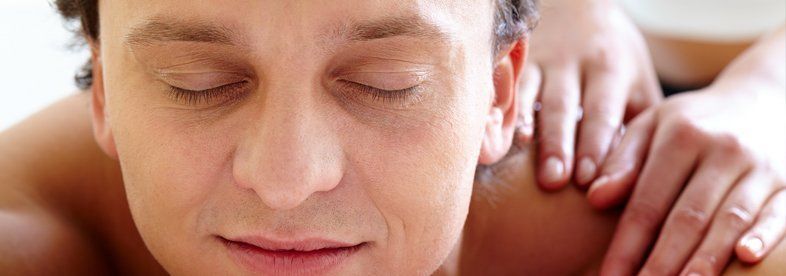Massage & Aromatherapy | Remedial/sports massage

What is Sports Massage?
Sports Massage is a deep tissue massage, using different techniques i.e., Muscle energy technique, Soft Tissue Release and Neuro-muscular techniques to manipulate soft tissue.
Sports massage is designed to assist in correcting problems and imbalances in soft tissue that are caused from repetitive and strenuous physical activity and trauma.
It helps to benefit the person engaged in regular physical activity.
The application of sports massage, prior to and after exercise may enhance performance, aid recovery and prevent injury.
Musculo-skeletal imbalances are often subtle and difficult to detect. The following contributes to the condition :
Environment
- includes the lifestyle, surroundings and occupation. Sitting at the desk all day, hours driving. You may need to check the way in which you sit at the desk, uses a computer, drives a car, lifts equipment. A simple act such as carrying a bag over a shoulder, can start of minor imbalances that can become chronic.
Stress
- most people have to deal with some pressure on a daily basis. At times the intensity of such pressure increases and the ability to cope with everyday task diminishes. This emotional stress often translates into tight muscles and postural problems. Persistent stress can also lead to weaknesses and problems in other body systems, often resulting in some form of illness.
Physical Activity
Very few physical activities are well balanced. Most favour one side of the body, which will set up imbalances. The favoured side of the body is stronger and has more muscle bulk. This can also lead to poorer range of motion in the affected joint.
Posture
Postural problems often result from secondary causes, such as environmental factor. They may be due simply to development of bad habits. Stress or work may influence the posture.
Hereditary
There simply may not be any satisfactory explanation for imbalances and the problem my have existed since birth.
Illness
Anyone who has endured even a short period of bed-rest due to illness is likely to suffer after-effects. Apart from feeling fatigued, the muscles may have weakened, atrophied and stiffened due to inactivity, all which may affect posture and gait.
Injury
Traumatic injury has many effects on the human body. First the body responds by protecting the site of injury. Movement becomes more
painful, partly because the soft tissue – now swollen with additional fluid – is less supple, and partly because any movement increases the pressure on the nerve endings. Increased muscle tension or even spasm will also limit the movement on the affected area. Increased pressure will impede blood vessels and neural pathways to the muscle, limiting the supplies of nerve impulses, blood, oxygen and nutrients, as well as the removal of waste products. Muscles that remain inactive will start to waste or atrophy, they will become inflexible and the muscle fibres and connective tissue will soon shorten. Muscle strength and power will be lost and joints affected by these muscles will not reach their full range of motion. The body will begin to compensate for these weakness and loss of function.
Some imbalances may develop gradually over many weeks, months or even years.
Musculo-skeletal imbalances may cause :-
- increased strain on muscles, tendons, ligaments and bones
- changes in soft tissue development
- changes in skeletal development (for chronic imbalances)
- reduced flexibility and range of motion
- muscle wasting or atrophy
- changes in strength,
- changes in reflex action
- discomfort or pain
- poorer posture
- poorer performance
Listen to what your body is telling you. Pain and muscle spasms are both part of the body’s reaction to injury, which acts as a defence mechanism against further injury.
Here are some of the symptoms one should be aware of :
- pain, usually in the joints
- stiffness in the joints and slight loss of movement
- not getting better in terms of performance, even after rest
- a change of contour of either bones, muscles or joints
- a burning sensation, tingling
- unexplained redness of the skin
- unexplained black or blue mark


